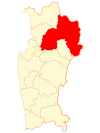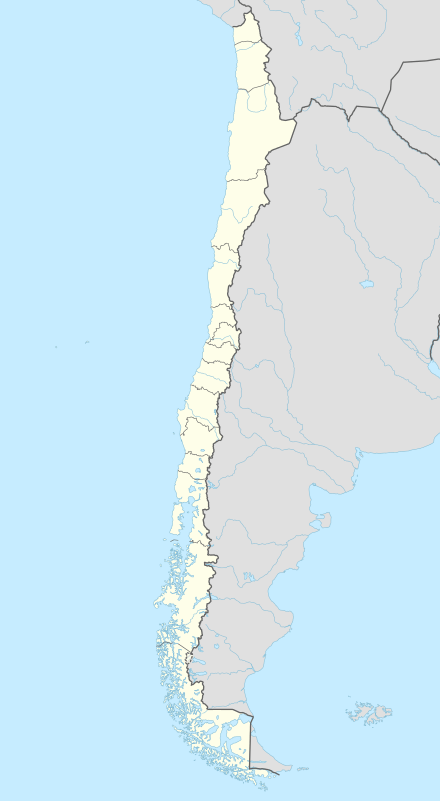Vicuña, Chile
| Vicuña | |||||
|---|---|---|---|---|---|
| City and Commune | |||||
|
Vicuña as seen from nearby hills. | |||||
| |||||
| Coordinates (city): 33°00′S 71°31′W / 33.000°S 71.517°WCoordinates: 33°00′S 71°31′W / 33.000°S 71.517°W | |||||
| Country |
| ||||
| Region |
| ||||
| Province | Elqui | ||||
| Vicuña | February 22, 1821 | ||||
| Government[1] | |||||
| • Type | Municipality | ||||
| • Alcalde | Fernando Guamán Guamán (Independent) | ||||
| Area[2] | |||||
| • Total | 7,609.8 km2 (2,938.2 sq mi) | ||||
| Elevation | 709 m (2,326 ft) | ||||
| Population (2012 Census)[2] | |||||
| • Total | 25,085 | ||||
| • Density | 3.3/km2 (8.5/sq mi) | ||||
| • Urban | 12,910 | ||||
| • Rural | 11,100 | ||||
| Demonym(s) | Vicuñense | ||||
| Sex[2] | |||||
| • Men | 12,302 | ||||
| • Women | 11,708 | ||||
| Time zone | CLT (UTC−4) | ||||
| • Summer (DST) | CLST (UTC−3) | ||||
| Area code(s) | 56 + 51 | ||||
| Website | Official website (Spanish) | ||||
Vicuña (Spanish pronunciation: [biˈkuɲa]) is a Chilean commune and city in Elqui Province, Coquimbo Region, founded during the government of Bernardo O'Higgins to secure sovereignty over the Elqui Valley. The famous Chilean poet Gabriela Mistral was born there in 1889. It shares borders to the west with the communes of La Higuera, La Serena and Andacollo, to the east with Argentina and to the south with Paihuano and Rio Hurtado. The commune is administered by the municipality of Vicuña, which is the principal city of the Valle de Elqui.
History
Vicuña was founded on February 22, 1821, by Colonel Joaquín Vicuña Larraín, who was the first intendant of Coquimbo's Province, by order of Bernardo O'Higgins, and was given the name of Villa de San Isidro de Vicuña. In 1872, it became a city and was called simply Vicuña, in honor of its founder.
Topography
The Vicuña commune covers an area of 7,609.8 km2 (2,938 sq mi), making it the largest commune in both the province and Coquimbo Region, and the second largest commune in the country.
Vicuña occupies the major part of the mid and upper Elqui river basin, and the entire Turbid river.

The area is dominated by a mountainous backdrop, with extensive plains on the valley floor, in which high quality grapes for pisco are cultivated along with other fruits and vegetables.
In the mountain ranges La Punilla, Atimonate, Balalita, Los Tilos and others there are several peaks of over 4,000 meters.
Demographics
According to the 2002 census by the National Statistics Institute, the commune covers an area of 7,609.8 km2 (2,938 sq mi) with a population of 24,010 inhabitants (12,302 male and 11,708 female). The population grew 10.8% (2,350 persons) between 1992 and 2002. There are 12,910 inhabitants in the urban area of the city of Vicuña and 11,100 in rural areas.
Economy
Vicuña is a major center for pisco production. CAPEL is the main pisco distillery in the zone. Its economic activity centers on the culture of grapes, fruits, cereals, and vegetables. Other industries include sheep ranching and iron and copper mining. The tourism industry has grown greatly in the last few years, primarily due to quality hotels and restaurants. One of the principal characteristics of Vicuña is that there are at least 300 totally clear days and nights, which is why local observatory Mamalluca provides guided astronomy tours. The urban area is made up of edifices from around 1900. The principal points of interest inside the city are its square of aged trees, which shows sculptures that honor Gabriela Mistral, who was awarded the Nobel prize in literature; the Temple of the Immaculate Conception; the Tower Bauer, which houses the office of tourism; and the museums of Gabriela Mistral.
Tourism

A few kilometres outside is the Route of the Grappa, visiting the factories known as pisqueras: Ruta Norte, Capel, Mistral, Tres Erres and Artesanos de Cochiguaz. Also the reservoir Puclaro, La Laguna, its natural viewpoints, the handicraft fairs and the Diaguita corner deserve a visit. Close to Vicuna one can visit picturesque townships like El Molle, El Tambo, Diaguitas, Rivadavia, Chapilca, Monte Grande and Pisco Elqui.
The Observatory Mammalluca located to 9 km to the north of the city of Vicuña, has tourist purposes and of education. At the Cerro Tololo Inter-American Observatory, only daily tourist visits are possible, and the telescopic observation is not possible except for specialists and astronomers. However, in Mamalluca, it is possible to observe using the telescope, both planets and visible stars during the starry nights of the Valle de Elqui. The observatory is near the illustrious municipality of Vicuna.[3]
Administration
The commune is administered by the alcalde Fernando Guamán Guamán (Ind.), who is advised by a municipal council of six members:[1]
- René Ahumada Tapia (RN)
- Simón Alquinta Sirvent (UDI)
- Carmen Luz Rojas Araya (PRSD)
- Silvia Piñones Rivera (PPC)
- Mario Aros Carvajal (Ind.)
- Leonor Ortega Wanders (PS)
Within the electoral divisions of Chile, Vicuña is represented in the Chamber of Deputies by deputies Marcelo Díaz (PS) and Mario Bertolino (RN) as a part of the 7th electoral district (together with La Serena, La Higuera, Paiguano and Andacollo). The commune is represented in the Senate by senators Evelyn Matthei (UDI) and Jorge Pizarro (PDC) as part of the 4th senatorial constituency (Coquimbo).
Sister towns
See also
References
- 1 2 "Municipality of Vicuña" (in Spanish). Retrieved 27 October 2010.
- 1 2 3 "National Statistics Institute" (in Spanish). Retrieved 8 September 2010.
- ↑ Mamalluca Observatory Retrieved: January 2, 2009.
External links
- (Spanish) Municipality of Vicuña
- (Spanish) Portal de Elqui
- (Spanish) Vicuña's Map
| Wikimedia Commons has media related to Vicuña, Chile. |





